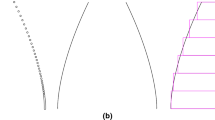The approach provides simulation of the gear design with high-precision profile configuration parameters to accurately predict its load capacity and stress state, which requires incessant efforts, as gear failure modes depend largely on its profile representation. The finite element analysis (FEA) is a well-known effective computational method, which many authors used to estimate the gear tooth strength against the primary failure modes of gears. This method is not only known to be time-consuming but often expensive, it employs approximate geometry that resulted in a coarse mesh. The tooth strength and deformation modes were obtained from a three-dimensional gear model based on the trivariate nonuniform rational B-splines (NURBS) under loading and investigated using the isogeometric analysis (IGA) for simulation. The results produced with the IGA simulation are compared with the corresponding values derived from the classical estimation method with the Lewis equation and FEM analysis using ANSYS. Both results are in good agreement and confirm that the IGA model is more accurate than the FEM one. This study demonstrated that IGA was practically applicable, providing an alternative means of using high-precision geometry of 3D models to estimate the behavior of gear bodies under loading and modify their strength calculations.









Similar content being viewed by others
References
D. Ristić, “Numerical model for the critical stress determination in spur gears,” Sci. Tech. Rev., LVIX, No. 1, 78–86 (2009).
S. Sankar, M. Sundar Raj, and M. Nataraj, “Profile modification for increasing the tooth strength in spur gear using CAD,” Engineering, 2, No. 9, 740–749 (2010).
L. Piegl and W. Tiller, The NURBS Book, 2nd ed., Springer-Verlag, Berlin–Heidelberg (1995).
T. J. R. Hughes, J. A. Cottrell, and Y. Bazilevs, “Isogeometric analysis: CAD, finite elements, NURBS, exact geometry and mesh refinement,” Comput. Methods Appl. Mech. Engrg., 194, 4135–4195 (2005).
Gear Technical Reference, KHK, Kohara Gear Industry Co Ltd, Japan.
I. Atanasovska and V. Nikoliã-Stanojeviã, “3D spur gear FEM model for the numerical calculation of face load factor,” Facta Universitatis, Ser. Mech. Autom. Contr. Robot., 6, No. 1, 131–143 (2007).
S. K. Tiwari and U. K. Joshi, “Stress analysis of mating involute spur gear teeth,” Int. J. Eng. Res. Technol., 1, Issue 9, 2173–2180 (2012).
V. Karaveer, A. Mogrekar, and T. P. Reynold Joseph, “Modeling and finite element analysis of spur gear,” Int. J. Current Eng. Technol., 3, No. 5, 2104–2107 (2013).
L. Beirão da Veiga, A. Buffa, C. Lovadina, et al., “An isogeometric method for the Reissner–Mindlin plate bending problem,” Comput. Methods Appl. Mech. Engrg., 209-212, 45–53 (2012).
W. A. Wall, M. A. Frenzel, and C. Cyron, “Isogeometric structural shape optimization,” Comput. Methods Appl. Mech. Engrg., 197, 2976–2988 (2008).
J. A. Cottrell, A. Reali, Y. Bazilevs, and T. J. R Hughes, “Isogeometric analysis of structural vibrations,” Comput. Methods Appl. Mech. Engrg., 195, 5257–5296 (2006).
R. L. Taylor, “Isogeometric analysis of nearly incompressible solids,” Int. J. Num. Meth. Eng., 87, No. 1-5, 273–288 (2011).
Y. Bazilevs, V. M. Calo, T. J. R. Hughes, and Y. Zhang, “Isogeometric fluid-structure interaction: theory, algorithms, and computations,” Comput. Mech., 43, 3–37 (2008).
M. J. Borden, C. V. Verhoosel, M. A. Scott, et al., “A phase-field description of dynamic brittle fracture,” Comput. Methods Appl. Mech. Engrg., 217-220, 77–95 (2012).
C. Miehe, F. Welschinger, and M. Hofacker, “Thermodynamically consistent phase- field models of fracture: Variational principles and multi-field FE implementations,” Int. J. Num. Meth. Eng., 83, No. 10, 1273–1311 (2010).
Y. Bazilevs, J. R. Gohean, T. J. R. Hughes, et al., “Patient-specific isogeometric fluid-structure interaction analysis of thoracic aortic blood flow due to implantation of the Jarvik 2000 left ventricular assist device,” Comput. Methods Appl. Mech. Engrg., 198, 3534–3550 (2009).
I. Temizer, P. Wriggers, and T. J. R. Hughes, “Contact treatment in isogeometric analysis with NURBS,” Comput. Methods Appl. Mech. Engrg., 200, 1100–1112 (2011).
L. de Lorenzis, I. Temizer, P. Wriggers, and G. Zavarise, “A large deformation frictional contact formulation using NURBS-based isogeometric analysis,” Int. J. Num. Meth. Eng., 87, No. 13, 1278–1300 (2011).
M. E. Matzen, T. Cichosz, and M. Bischoff, “A point to segment contact formulation for isogeometric, NURBS based finite elements,” Comput. Methods Appl. Mech. Engrg., 255, 27–39 (2013).
Q. Cheng, G. Yang, and J. Lu, “An analysis of gear based on isogeometric analysis,” Vibroeng. Proc., 2, 17–22 (2013).
G. Maruniã, “Rim stress of thin-rimmed gear,” Adv. Eng., 2, 65–72 (2008).
W. D. Pilkey and D. F. Pilkey, Peterson’s Stress Concentration Factors, 3rd edition, John Wiley & Sons, Inc., Hoboken–New Jersey (2008), pp. 49–51.
L. Beirão da Veiga, D. Cho, L. F. Pavarino, and S. Scacchi, “Overlapping Schwarz methods for isogeometric analysis,” SIAM J. Numer. Anal., 50, No. 3, 1394–1416 (2012).
C. de Falco, A. Reali, and R. Vázquez, “GeoPDEs: a research tool for isogeometric analysis of PDEs,” Adv. Eng. Software, 42, Issue 12, 1020–1034 (2011).
V. P. Nguyena, S. P. A. Bordas, and T. Rabczuk, Isogeometric Analysis: An Overview and Computer Implementation Aspects, Cardiff University (2013).
A. Duval, H. Al-Akhras, F. Maurin, et M. Elguedj, “Implementing isogeometric elements in Abaqus and development of dedicated tools for pre- and post-processing,” 11th National Symposium in Calculation of Structures (CSMA 2013, 13–17 Mai 2013).
T. W. Sederberg, J. Zheng, A. Bakenov, and A. Nasri, “T-splines and T-NURCCs,” ACM Trans. Graphics, 22, 477–484 (2003).
Acknowledgments
The authors acknowledge the support by National Nature Science Foundation of China (Project Numbers 61170198 and 51305016) and the Fundamental Research Funds for the Central Universities in China.
Author information
Authors and Affiliations
Corresponding author
Additional information
Translated from Problemy Prochnosti, No. 1, pp. 26 – 36, January – February, 2015.
Rights and permissions
About this article
Cite this article
Yusuf, O.T., Zhao, G., Wang, W. et al. Simulation Based on Trivariate Nurbs and Isogeometric Analysis of a Spur Gear. Strength Mater 47, 19–28 (2015). https://doi.org/10.1007/s11223-015-9623-5
Received:
Published:
Issue Date:
DOI: https://doi.org/10.1007/s11223-015-9623-5




